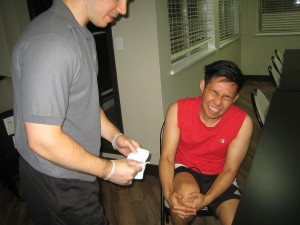Patellar subluxation is described as incomplete dislocation of a kneecap. The kneecap can move out of its usual position easily when the thigh muscles are weak and the patella is not properly connected by the neighboring tendons and ligaments or there are problems with the structure of the bones and alignment.
The kneecap is shifting in and out of its proper position but it usually moves back to its normal position by itself. With repeated incidents, this can damage the cartilage found at the back of the patella or the connective ligaments can be stretched. Patella subluxation can be caused by sudden twisting of the knee due to a strong impact on the patella.
Causes of patellar subluxation
- Forceful extension of the knee
- Direct strong trauma on the patella or on the side of the knee
- Quick twisting of the lower leg while standing or running and walking
- Broad pelvis
- Shallow groove in the area which develops usually from birth

Severe pain can be felt in front of the knee and becomes worse especially when walking or moving the joint. - Severe muscle contraction of the thigh
- Tight or loose ligaments
- Abnormal way of walking due to a defect in the bone of the leg
People playing contact sports such as hockey, football, basketball, rugby are at high risk for patellar subluxation. Women with wide pelvis, obese and with a history of knee injuries are susceptible to patellar subluxation.
Symptoms
- Severe pain can be felt in front of the knee and becomes worse especially when walking or moving the joint.
- There is swelling of the knee immediately after the patella is displaced.
- The area is tender to the touch and bruising manifests due to the buildup of blood under the skin.
- Changes in the color of the skin such as red or purple.
- Crackling sound can be heard when bending or straightening the knee
- Instability of the knee or a feeling as if the knee is about to give away. There is a risk of falling or losing balance when suffering from patellar subluxation.
- Deformity of the patella when it is dislocated outside of the knee.
Treatment
- Take plenty of rest especially the affected area and for fast healing of the injured ligament around the patella.
- Apply an ice pack on the affected area for at least 10-15 minutes at 3 times every day to lessen the inflammation and pain. Avoid applying the pack directly on the skin to prevent frostbite that can worsen the condition. Wrap the pack using a towel before applied on the area.
- Elevate the affected knee above the level of the heart. Raise the knee on pillows while sitting or lying on bed.
- Take the prescribed over-the-counter anti-inflammatory medications such as ibuprofen for a few days to lessen the swelling and pain.
- Wear a knee brace to prevent unnecessary movement, maintain stability of the knee and keep the patella in its groove.
- Seek the help of the physical therapist for some rehabilitation exercises needed to improve the mobility and strength of the knee.
- Wear comfortable footwear to improve the way of walking and for fast healing of the patellar subluxation. Complete recovery from this condition usually takes about 6 six weeks.
Disclaimer / More Information
The material posted on this page on patellar subluxation is for learning purposes only. Learn to recognize and manage joint injuries including patellar subluxation by taking a first aid and CPR class with one of our training providers.
